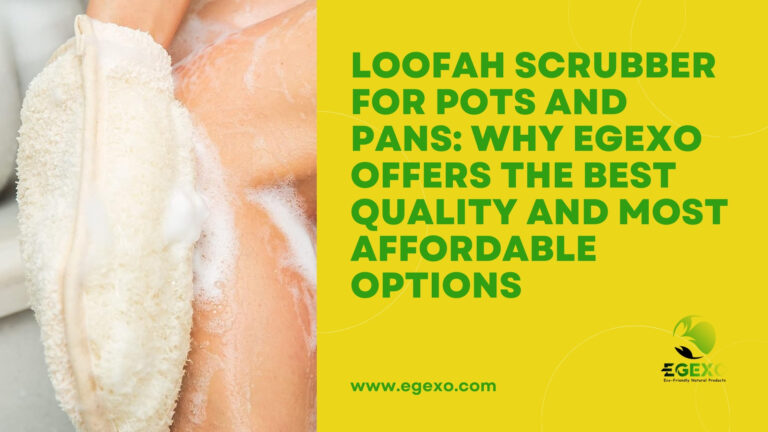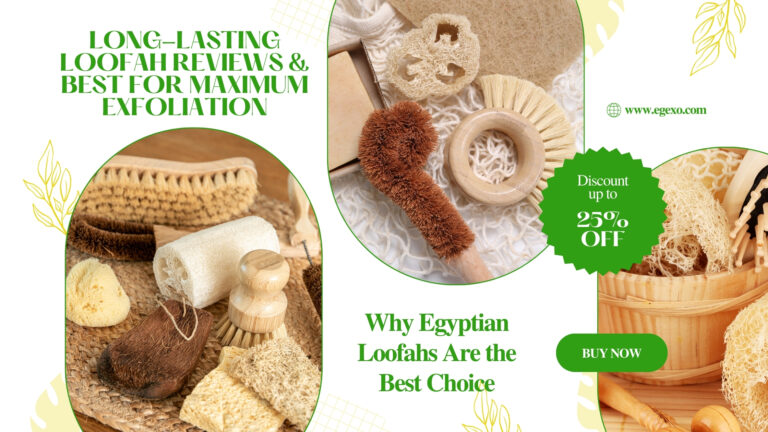Discovering the Benefits of Luffa Plant and Luffa Scrub for Natural Skincare
In recent years, the natural skincare movement has gained popularity as more people look for alternatives to synthetic products filled with chemicals. One of nature’s gems for skincare enthusiasts is the Luffa plant. This unique, sponge-producing plant has become a go-to solution for those seeking eco-friendly, natural exfoliation. Not only is it beneficial for skincare, but it’s also versatile, sustainable, and can be easily grown.
In this post, we’ll explore everything you need to know about the Luffa plant and the benefits of using luffa scrub in your skincare routine. We’ll also share why Egyptian loofahs from EGEXO make the best choice for bath and body care.
What is the Luffa Plant?
The Luffa plant (commonly spelled “loofah”) belongs to the cucumber family (Cucurbitaceae) and is native to tropical regions. It produces a fibrous fruit that, when dried, can be used as a natural scrub sponge. This plant is commonly grown for its fibrous interior, which becomes the popular exfoliating luffa sponge used in both skincare and household cleaning.
There are two primary types of luffa commonly cultivated for use:
- Luffaaegyptiaca: Known as the smooth luffa, commonly used in skincare.
- Luffaacutangula: Known as angled luffa, which has similar uses but a slightly different texture and structure.
The Luffa plant grows best in warm climates and can be cultivated by planting seeds, allowing the fruit to develop, and drying it to reveal its fibrous interior. In Egypt, the climate is ideal for growing high-quality luffa, which is why EGEXO specializes in growing and exporting some of the finest Egyptian loofahs worldwide.
How is the Luffa Plant Cultivated?
Growing the Luffa plant requires patience, but the results are well worth it. Here’s a simple overview of the cultivation process:
- Planting Seeds: Luffa seeds are planted in well-draining soil with plenty of sunlight. Warm temperatures between 70°F and 85°F (21°C-29°C) are ideal for optimal growth.
- Growth Period: The plant grows quickly and can reach heights of up to 15 feet, with vines climbing over trellises or other structures. It flowers in clusters, and after pollination, elongated fruits begin to develop.
- Harvesting: Luffa fruits are harvested once they are mature and begin to dry out on the vine. The skin becomes brown and crisp, indicating they are ready for the next step.
- Drying and Processing: The harvested luffa fruit is peeled to remove the outer shell, leaving behind the fibrous skeleton inside. This structure is then thoroughly cleaned, bleached if desired, and dried to create the final sponge.
The Benefits of Using a Natural Luffa Scrub
When it comes to skincare, luffa scrubs offer numerous benefits, making them a fantastic addition to your beauty routine. Let’s delve into the ways that luffa scrub can elevate your skincare:
- Exfoliation: The natural texture of the luffa is perfect for exfoliating dead skin cells, leaving your skin smoother and softer. Regular exfoliation with a luffa scrub can improve circulation, promote cell renewal, and help achieve a more radiant complexion.
- Improves Skin Texture: With consistent use, a luffa scrub helps to smooth out rough patches and improve skin texture. It’s especially effective on areas like elbows, knees, and feet, where skin tends to be tougher and requires more exfoliation.
- Prevents Ingrown Hairs: Exfoliating with a luffa scrub before shaving helps to prevent ingrown hairs by removing dead skin cells that could clog pores. This leaves your skin better prepared for a close shave and minimizes the likelihood of irritation.
- Reduces the Appearance of Cellulite: Regularly massaging with a luffa scrub stimulates blood flow and helps to break down fat deposits, which may help reduce the appearance of cellulite over time.
- Supports Sustainable Living: Unlike synthetic exfoliating tools or plastic scrubs, luffa is entirely biodegradable. This makes it a fantastic eco-friendly alternative for those aiming to reduce their plastic waste and make sustainable lifestyle choices.
- Gentle Enough for Sensitive Skin: Luffa scrubs can be tailored for various skin types by adjusting the pressure applied during use. Those with sensitive skin can use a luffa scrub gently to achieve effective exfoliation without irritation.
Why Egyptian Loofahs from EGEXO Are Ideal for Bath and Body Use
Not all loofahs are created equal. Egyptian loofahs, in particular, have a distinct reputation for being exceptionally high in quality, offering a soft yet effective exfoliating experience that’s ideal for bath and body care. Here’s why EGEXO’s Egyptian loofahs stand out:
- Premium Quality and Texture: Egyptian loofahs are known for their unique texture and durability, making them perfect for frequent use. They retain their shape and provide consistent exfoliation, unlike many other types of loofahs that may break down over time.
- Affordable and Sustainable: As one of the leading suppliers of Egyptian loofahs, EGEXO provides high-quality products at affordable prices, making it easier for consumers to adopt eco-friendly habits without breaking the bank.
- Perfect for Customization: EGEXO offers private label and custom product design services, allowing brands and businesses to create unique, branded loofah products that meet their exact specifications. This customization makes Egyptian loofahs a great choice for retailers looking to offer premium, personalized skincare tools.
- Naturally Processed: EGEXO’s loofahs are naturally processed to ensure the highest quality without introducing harmful chemicals. This natural approach preserves the loofah’s integrity, making it safer for your skin and the environment.
- Versatile for Bath, Body, and Kitchen: Egyptian loofahs from EGEXO aren’t just for skincare—they’re versatile enough to be used in the kitchen as well. Their sturdy, absorbent structure makes them ideal for cleaning surfaces, scrubbing dishes, and more.
How to Use a Luffa Scrub for Best Results
Using a luffa scrub correctly will ensure you get the best results while protecting your skin. Here’s a quick guide to using a luffa scrub in your routine:
- Preparation: Soak the luffa scrub in warm water for a few minutes to soften it slightly. This will make it gentler on your skin and reduce the risk of irritation.
- Exfoliating: Apply your favorite body wash or natural soap to the luffa scrub, then gently massage it onto your skin in circular motions. Focus on areas that need extra attention, like elbows, knees, and feet.
- Rinse Thoroughly: After exfoliating, rinse your skin well to remove any dead skin cells, then pat dry with a towel.
- Moisturize: Follow up with a moisturizer to lock in hydration and keep your skin soft and smooth.
- Care for Your Luffa: Rinse the luffa scrub thoroughly after each use, and allow it to dry completely in a well-ventilated area. This will prevent bacteria growth and keep it in good condition.
Why Choose EGEXO for Egyptian Loofahs?
At EGEXO, we pride ourselves on being a trusted provider of top-quality Egyptian loofahs. Our expertise in cultivating, manufacturing, and exporting loofah products makes us a reliable choice for individuals and businesses worldwide. Our Egyptian loofahs stand out for their quality, affordability, and natural origins.
Whether you’re looking to add a natural exfoliating tool to your skincare routine or offer sustainable, private-label loofah products to your customers, EGEXO has you covered. Our loofahs are affordable, versatile, and customizable to meet a wide range of needs, from personal skincare to commercial applications.
Final Thoughts
Incorporating a luffa scrub into your skincare routine can transform your exfoliation experience. From removing dead skin cells to promoting smoother skin, luffa scrubs are an eco-friendly, effective way to take care of your skin. When you choose an Egyptian loofah from EGEXO, you’re not only supporting sustainable skincare but also enjoying the benefits of high-quality, naturally processed loofahs.
If you’re ready to elevate your bath and body routine with Egyptian loofahs, explore the products from EGEXO and discover the perfect blend of affordability, quality, and sustainability.







